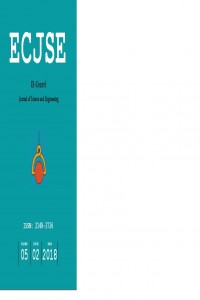Abstract
Abstract: Wearable electronic textiles have become
increasingly important in daily life. Such garments are based on sensors that
are distributed on the human body. These sensors should be comfortable and fit
for the aim of the wearer. In general, these textiles have been used for
pressure, stretch and temperature sensors. In this study, electrically conductive nonwoven fabrics were prepared by Drop Casting-Drying method and
their pressure
sensing behavior was investigated.
Özet: Giyilebilir
elektronik tekstiller günlük yaşamda giderek daha çok önemli hale gelmektedir.
Böyle giysiler, insan vücudu üzerine dağıtılan sensörlere bağlıdır. Bu
sensörler, giyen için konforlu ve amaca uygun olmalıdır. Genelde bu tekstiller
basınç, germe ve sıcaklık sensörleri için kullanılmaktadır. Bu çalışmada,
elektriksel olarak iletken nonwoven kumaşlar Drop Casting-Drying metodu yoluyla
hazırlanmış ve basınç sensör davranışları araştırılmıştır.
Keywords
References
- [1] Arogbonlo, A, C Usma, A Z Kouzani, and I Gibson. Design and Fabrication of a Capacitance Based Wearable Pressure Sensor Using E-Textiles. Procedia Technology 2015; 270–75.
- [2] Lee J, Kwon H, Seo J, Shin S, Koo JH, Pang C, et al. Conductive fiber-based ultrasensitive textile pressure sensor for wearable electronics. Adv Mater. 2015;27(15):2433–9.
- [3] Coyle S, Morris D, Lau KT, Diamond D, Moyna N. Textile-based wearable sensors for assisting sports performance. Proc - 2009 6th Int Work Wearable Implant Body Sens Networks, BSN 2009. 2009;307–11.
- [4] Alhashmi Alamer F. A simple method for fabricating highly electrically conductive cotton fabric without metals or nanoparticles, using PEDOT:PSS. J Alloys Compd. 2017;702:266–73.
- [5] Kanara,Ş. Investıgatıon of Electrıcal, Electromagnetıc Shıeldıng and Sensor Behavıors of Conductıve Polymerıc Composıte Textıle Surfaces, M.Thesis, Kahramanmaras Sutcu İmam University, Institute of Science, (2014)
- [6] Hajfarajollah, H., Mehvari, S., Habibian, M., Mokhtarani, B., Noghabi, K.A. Rhamnolipid biosurfactant adsorption on a plasma-treated polypropylene surface to induce antimicrobial and antiadhesive properties, RSC Advances, 2015; 42 (5), 33089-33097.
- [7] Chang HC, Sun T, Sultana N, Lim MM, Khan TH, Ismail AF. Conductive PEDOT:PSS coated polylactide (PLA) and poly(3-hydroxybutyrate-co-3-hydroxyvalerate) (PHBV) electrospun membranes: Fabrication and characterization. Mater Sci Eng C. 2016;61:396–410.
- [8] Berendjchi A, Khajavi R, Yousefi AA, Yazdanshenas ME. A facile route for fabricating a dye sensitized solar cell on a polyester fabric substrate. J Clean Prod. 2017;149:521–7.
- [9] Merlini C, Almeida RDS, D’Ávila MA, Schreiner WH, De Oliveira Barra GM. Development of a novel pressure sensing material based on polypyrrole-coated electrospun poly(vinylidene fluoride) fibers. Mater Sci Eng B Solid-State Mater Adv Technol. 2014;179(1):52–9.
- [10] Wang D, Li H, Li M, Jiang H, Xia M, Zhou Z. Stretchable conductive polyurethane elastomer in situ polymerized with multi-walled carbon nanotubes. J Mater Chem C. 2013;1(15):2744–9.
Abstract
References
- [1] Arogbonlo, A, C Usma, A Z Kouzani, and I Gibson. Design and Fabrication of a Capacitance Based Wearable Pressure Sensor Using E-Textiles. Procedia Technology 2015; 270–75.
- [2] Lee J, Kwon H, Seo J, Shin S, Koo JH, Pang C, et al. Conductive fiber-based ultrasensitive textile pressure sensor for wearable electronics. Adv Mater. 2015;27(15):2433–9.
- [3] Coyle S, Morris D, Lau KT, Diamond D, Moyna N. Textile-based wearable sensors for assisting sports performance. Proc - 2009 6th Int Work Wearable Implant Body Sens Networks, BSN 2009. 2009;307–11.
- [4] Alhashmi Alamer F. A simple method for fabricating highly electrically conductive cotton fabric without metals or nanoparticles, using PEDOT:PSS. J Alloys Compd. 2017;702:266–73.
- [5] Kanara,Ş. Investıgatıon of Electrıcal, Electromagnetıc Shıeldıng and Sensor Behavıors of Conductıve Polymerıc Composıte Textıle Surfaces, M.Thesis, Kahramanmaras Sutcu İmam University, Institute of Science, (2014)
- [6] Hajfarajollah, H., Mehvari, S., Habibian, M., Mokhtarani, B., Noghabi, K.A. Rhamnolipid biosurfactant adsorption on a plasma-treated polypropylene surface to induce antimicrobial and antiadhesive properties, RSC Advances, 2015; 42 (5), 33089-33097.
- [7] Chang HC, Sun T, Sultana N, Lim MM, Khan TH, Ismail AF. Conductive PEDOT:PSS coated polylactide (PLA) and poly(3-hydroxybutyrate-co-3-hydroxyvalerate) (PHBV) electrospun membranes: Fabrication and characterization. Mater Sci Eng C. 2016;61:396–410.
- [8] Berendjchi A, Khajavi R, Yousefi AA, Yazdanshenas ME. A facile route for fabricating a dye sensitized solar cell on a polyester fabric substrate. J Clean Prod. 2017;149:521–7.
- [9] Merlini C, Almeida RDS, D’Ávila MA, Schreiner WH, De Oliveira Barra GM. Development of a novel pressure sensing material based on polypyrrole-coated electrospun poly(vinylidene fluoride) fibers. Mater Sci Eng B Solid-State Mater Adv Technol. 2014;179(1):52–9.
- [10] Wang D, Li H, Li M, Jiang H, Xia M, Zhou Z. Stretchable conductive polyurethane elastomer in situ polymerized with multi-walled carbon nanotubes. J Mater Chem C. 2013;1(15):2744–9.
Details
| Primary Language | English |
|---|---|
| Subjects | Engineering |
| Journal Section | Makaleler |
| Authors | |
| Publication Date | May 31, 2018 |
| Submission Date | January 3, 2018 |
| Acceptance Date | January 4, 2018 |
| Published in Issue | Year 2018 Volume: 5 Issue: 2 |



